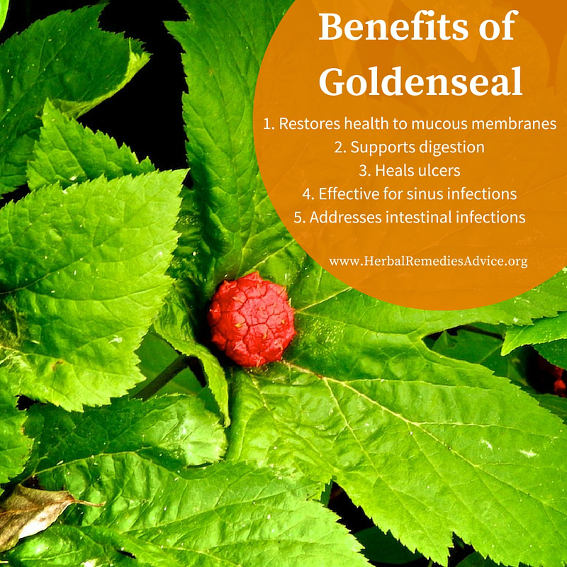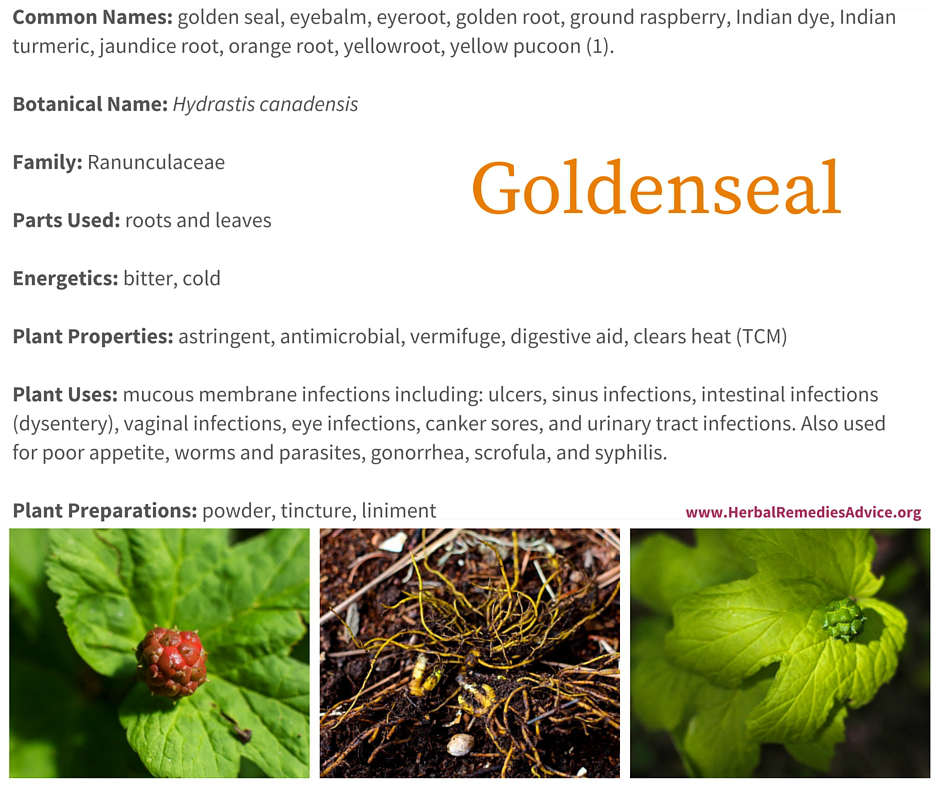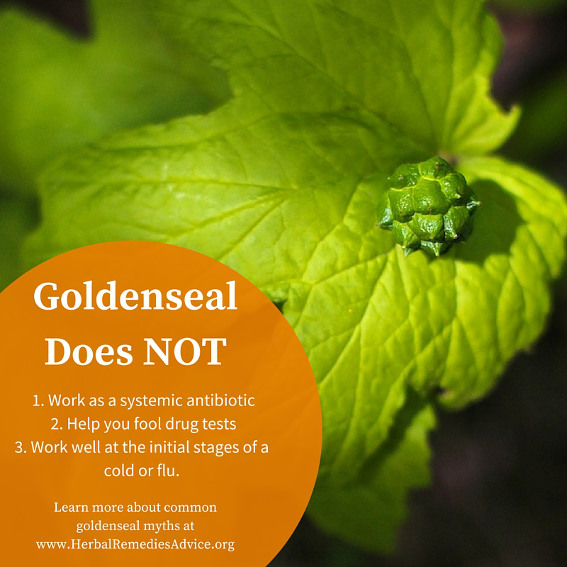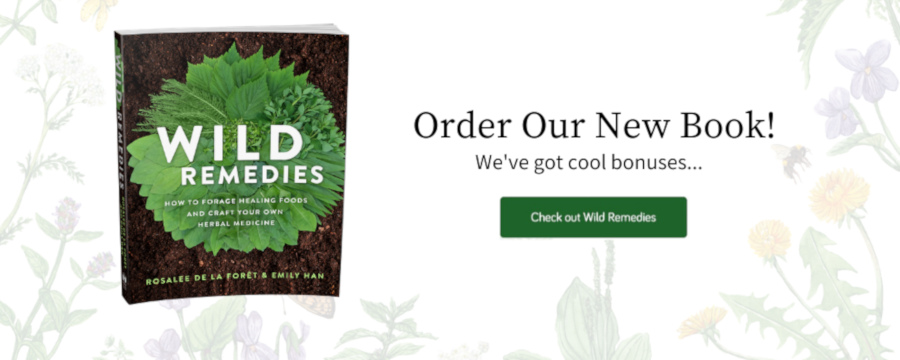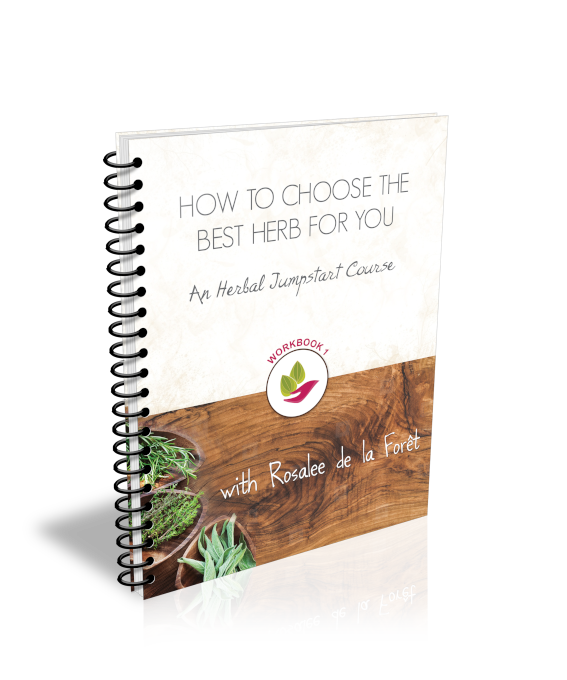Get weekly tips, recipes, and my Herbal Jumpstart e-course! Sign up for free today.

Benefits of Goldenseal
Share this! |
|
Goldenseal presents a tragic story of what can happen when an herb is misunderstood, unethically marketed, and subsequently overused. This understory native plant used to cover the floor of the eastern forests, but it has been severely over-harvested, leaving the future of this important medicinal herb in question. The worst part is that many people overuse or misuse this herb, falsely believing it is an herbal antibiotic or taking it in the hopes it will help them pass a drug test (FYI: it won’t).2
The truth is, goldenseal is an important, highly effective medicinal plant, but it has a very specific use for boggy and inflamed mucus membranes. While it can be useful for certain types of infections, it does not work systemically like antibiotic pharmaceuticals.
“In my experience both selling herbs at retail, and seeing patients in the clinic, not even 10% of the goldenseal use in the U.S. is clinically appropriate. When someone pops large amounts of goldenseal "for a cold," especially in its early stages, they are wasting both their money and an endangered plant.”3 - Paul Bergner, Herbalist
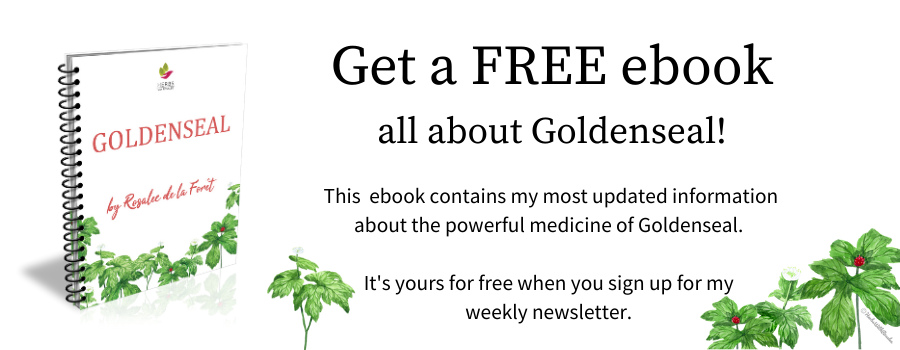
Benefits of Goldenseal: Energetics Overview
The first key to understanding how goldenseal works lies within its energetics. In Western Herbalism, Goldenseal is bitter, cold, and astringent. In Chinese Medicine these qualities are used to clear heat and drain dampness (both of which indicate possible infection).
As an astringent herb, it tones and tightens mucous membranes. This is one of our most important herbal actions for addressing infections located in our mucous membranes. By toning lax tissues, goldenseal helps to secure our mucous membranes as an important barrier between ourselves and the outside world.
Herbalists sometimes refer to goldenseal as a mucous membrane trophorestorative because it balances the mucous membranes. It can both increase mucosal secretions and inhibit mucosal secretions, depending on the need of the individual. This works best with smaller dosages as large dosages tend to be more strongly astringent, thus drying out the mucosal membranes (which is often inappropriate).
“In its action on mucous membranes, hydrastis [goldenseal] first secures the separation and discharge of any viscid secretion; then diminishes the secretion without reducing it below the normal quantity, and renders it more healthy in character; and at the same time relieves turgid conditions and achings, and disposes any ulcerated portions to heal. These actions are very decided and peculiar, and render this agent one of rare value in all affections that come under this head.”4
- William Cook, The Physiomedical Dispensatory, 1869
Benefits of Goldenseal: Using Goldenseal Standard Extract or the Whole Goldenseal Plant?
Researchers have mostly bypassed goldenseal as a whole plant and instead have focused on its alkaloidal constituents such as berberine and hydrastine. Both of these alkaloids are known to have antimicrobial properties. However, several studies have shown that using the whole plant is more effective than using the isolated constituents. This is not a surprise to herbalists!
When I say whole plant, I mean it. Most herbalists today use only the root; however, scientific studies have shown that goldenseal leaf may work in similar ways to the root, which may give us an effective and sustainable way to use this plant. This habit of using the root probably came about because roots were easier to dry and keep and transport in the early days of Western Herbalism.
One especially interesting study showed that while the root contains higher levels of alkaloids than the aerial portions, the aerial portions synergize with berberine better. The leaves, and not the roots, were also shown to have efflux pump inhibitors.5 Efflux pump inhibitors are being studied as a way to address antibiotic resistant staph infections.
Benefits of Goldenseal for Digestive Disorders
Goldenseal root has long been used for healing external and internal ulcers. This can include ulcers and wounds on the skin, as well as digestive ulcers. It is one of my favorite plants for digestive ulcers. I first learned of this use from my mentor K.P. Khalsa, and have seen it work for a handful of my own clients. Science has begun to validate this use by showing goldenseal's effectiveness (in vitro) against Helicobacter pylori (H. pylori), an opportunistic bacterial infection that is often found in patients with peptic ulcers.6
Goldenseal has long been used as a digestive tonic. Historically it was indicated for a “sour” stomach and general dyspepsia. Samuel Thompson recommended it for “correction of the bile,” hinting at its effect on the liver. William Cook, author of the Physiomedical Dispensatory (1869), said that “it improves appetite and digestion; and through the stomach proves one of the most acceptable of all general tonics in indigestion, feeble assimilation, biliousness, leucorrhea, prolapses, and all forms of debility.”7
In addition to people with ulcers, I regularly use it in practice with people who have inflammatory bowel disease accompanied by mucus secretions in the stool.
Benefits of Goldenseal for Diarrhea and Dysentery
Goldenseal, and another berberine-containing plant, Coptis, were famously used by the Eclectic Physicians during cholera and dysentery outbreaks. People with these infections end up dying from severe dehydration due to copious fluid loss through diarrhea. Taking these herbs dramatically stopped the watery diarrhea.
One might think that this dramatic action against dysentery is proof that goldenseal is an antibiotic or that it might potentially have a negative effect on bowel flora. However, one study found that it didn’t kill the microbes causing the diarrhea, but instead worked through some other mechanism.8
Benefits of Goldenseal for Colds and the Flu
Many people like to use goldenseal at the beginning of a cold or flu, citing its antibiotic qualities for its effectiveness. Unfortunately, this is misguided in several ways. First, as stated above, goldenseal is not specifically antimicrobial. Second, our cultural overuse of antibiotics has programmed people to believe they need an antibiotic for their cold or flu, when these viral infections really are not effected by drugs that kill bacteria. Third, herbalist Paul Bergner cautions specifically against using goldenseal during the beginning stages of a cold or flu because it may dry up mucus, which is one of our best natural immune system defenses against invading pathogens.
Is goldenseal an antiviral herb? One study has shown that high doses of goldenseal extract were found to be effective against a flu virus (H1N1) in a petri dish, but it is unlikely that the human body could achieve a similar concentration.9 Unfortunately, this petri dish study has been the basis for less discerning alternative health practitioners to claim that goldenseal is an effective antiviral for humans.
There are many references to the Appalachian use of using goldenseal gargles for relieving a sore throat. This topical application of goldenseal on the mucosal membranes is in line with our current understanding of how best to use this mucus membrane herb.10
Goldenseal could be a good choice for the later stages of a cold or flu, if a secondary bacterial or fungal infection of mucus membranes sets in, such as a sinus infection. Speaking of which…
Benefits of Goldenseal for Sinus Infections
I’ve seen goldenseal address many chronic sinus infections. This is probably due to both its tonifying effect on the mucous membranes and due to its antifungal properties. Most chronic sinus infections are due to fungal infections and not bacterial infections as we once thought.11
Benefits of Goldenseal Found in Research
Researchers have only done a handful of studies specifically on goldenseal root and leaf. Most of these studies have been done in vitro and not in human subjects. While some of these studies are interesting, we should always keep in mind that what happens in a petri dish may or may not be what happens in the human body. However, some of these studies may be pointing the way for unique applications and uses of this plant.
Did you know that bacterial cells can communicate with each other? Termed quorum sensing, this complex system of communication helps bacteria to invest their energies to multiply at moments when they know they can thrive. An in vitro study showed that goldenseal leaf was more effective than the isolated constituent berberine in combatting staph infections. It also showed that the leaf was able to stop quorum sensing in bacterial cells.12
In another study, chemical isolates from goldenseal were shown to be effective in vitro against common pathogens found in the mouth. This tells us that using goldenseal extract in a mouth wash may be a way to reduce pathogens known to cause gum disease, with the added beneficial effects on the mucus membranes of the mouth. I like to use Oregon Grape, a more common plant that contains berberine, in my mouth wash.13
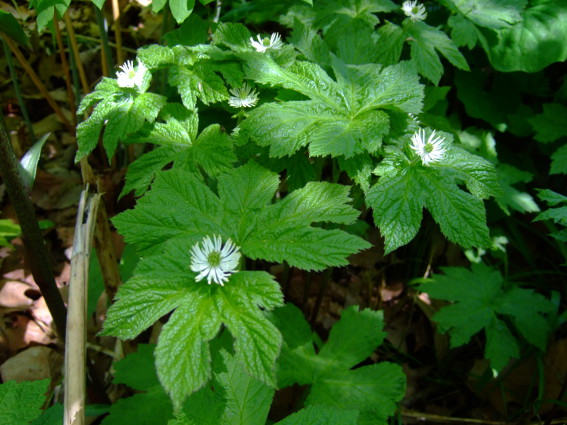 PHOTO CREDIT: By James Steakley (Own work) via Wikimedia Commons
PHOTO CREDIT: By James Steakley (Own work) via Wikimedia CommonsHistorical Goldenseal Medicinal Uses
Various North American Native tribes used goldenseal as medicine. In his book, Native American Ethnobotany, Daniel Moerman lists numerous traditional uses for goldenseal, including for local inflammations (as a wash), for general debility, as eye and ear medicine, for liver trouble and a sour stomach, for diarrhea, for cancer, to improve appetite, and for tuberculosis.14
Samuel Thompson, the founder of Thompsonian medicine famously used goldenseal in his patented formulas.
The Eclectic Physicians continued with the use of goldenseal, specifically using it for digestion and as a mucous membrane tonic. It was additionally used for urinary tract infections. They also began to use it as an astringent agent for a variety of female reproductive disorders, including dysmenorrhea and fibroids.
Medicinal Uses of Goldenseal
Please, please, please only use cultivated goldenseal root. It has been ravaged in the wild and needs to recover. Cultivated Goldenseal root is admittedly expensive, but it is worth supporting a sustainable source for this important herb. Other herbs such as Oregon Grape and Coptis may be a better choice if the action of berberine is the main requirement. Here’s an article from Paul Bergner highlighting Coptis as a goldenseal substitute.
Science has recently pointed the way towards using goldenseal leaf. This needs to be explored more fully and may offer a potent and sustainable alternative to the root.
Researchers have focused a lot of their efforts on isolated berberine, a chemical alkaloid found in goldenseal, Coptis (Coptis chinensis), Oregon grape (Mahonia/Berberis spp.), and barberry (Berberis vulgaris). Isolated berberine has been found to be effective in a number of health conditions, and it is fortunately available from plants that are much more common than goldenseal. Meanwhile, the whole-plant medicine of goldenseal can be saved for use in specific conditions that require the blended benefits of mucus membrane tonic and on-contact antimicrobial action.
The eclectics seemed to have used goldenseal as a tea, but because it is such a bitter plant, I prefer to use the tincture or encapsulated powder.
Dosage suggestions for goldenseal vary widely between herbalists. I learned to use large doses of goldenseal root powder for sinus infections and ulcers from my mentor, KP Khalsa. I have seen these large doses work well with no ill effects. I’ve also used large doses for people with acute attacks of inflammatory bowel disease; however, large doses are best for short-term use. Not only is short-term use a good match for the cold energetics of goldenseal, I’ve also seen people develop an aversion to it when taken long-term. I’m curious if using the leaf combined with the root would lead to lower doses being more effective.
Paul Bergner promotes the use of smaller tincture dosages, recommending 10-15 drops in a bit of water. He cautions against larger dosages, which he says will be too drying to the mucous membranes.
Powder: .5-10 grams per day
Tincture: 15 drops to 90 drops, TID
Goldenseal Side Effects
Goldenseal may interact with drugs that are CYP3A substrates.15
It is generally recommended to avoid goldenseal during pregnancy and breastfeeding. However, this appears to be based on studies where animals were given obscene amounts of the herb.
This whole article may sound like exaggerated praise of [goldenseal]; but, when kept to its true place, I am fully confident that it will be found deserving of every thing here said in its favor. - William Cook, The Physiomedical Dispensatory, 1869
The Goldenseal Plant
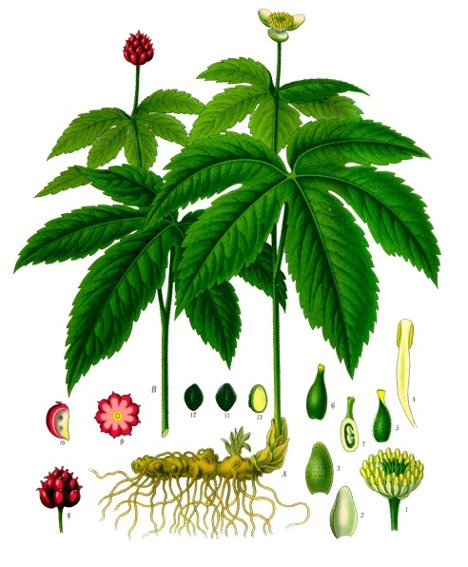
Goldenseal is an understory plant that thrives in the rich soils of wet shady forests in eastern North America. It is a small, perennial herbaceous plant.
Each plant produces a single flower with a green center and white petals with green tips.
By the summer it produces a berry reminiscent of raspberries that is inedible to humans.
The large leaves are palmate or maple-like in appearance. The rhizomes or root of the plant are small, stringy and bright yellow.
Summary of Benefits of Goldenseal
I was recently visiting Ancestree Herbals, a small herb farm located near my home. A brief walk through the medicinal forest soon brought me to an area carpeted with goldenseal. It was cooler in the shade and I was easily tempted to spend time with the ripe red berries that were cozily nestled in the green leaves. This abundance of goldenseal was carefully propagated in a shady grove in our dry high desert climate, providing a sustainable alternative to wild harvested goldenseal.
I adore goldenseal and often opt to use the expensive cultivated goldenseal root in place of other berberine-containing plants. Its effects on the mucous membranes are pronounced and specific, and it’s the first thing I reach for when working with people who have chronic sinus infections, peptic ulcers, or inflammatory bowel disease. There fortunately are alternatives to goldenseal. While we don’t know of one plant that works in exactly the same manner, we certainly have many digestive bitters to choose from and we have the ability to make herbal formulas with other astringents that can affect the mucous membranes in a similar way.
Goldenseal is one of the most famous medicinal plants endemic to North America. Let’s vow to keep this national treasure in the wild and rely on cultivated sources or other herbal alternatives.
Further Resources for Benefits of Goldenseal
For more information on goldenseal I highly recommend Paul Bergner’s book, The Healing Power of Echinacea and Goldenseal.
Here is an article from Paul Bergner with a lot of the information found in his book.
Research Sources for Benefits of Goldenseal
Click to show/hide.
Rosalee is an herbalist and author of the bestselling book Alchemy of Herbs: Transform Everyday Ingredients Into Foods & Remedies That Healand co-author of the bestselling book Wild Remedies: How to Forage Healing Foods and Craft Your Own Herbal Medicine. She's a registered herbalist with the American Herbalist Guild and has taught thousands of students through her online courses. Read about how Rosalee went from having a terminal illness to being a bestselling author in her full story here.
